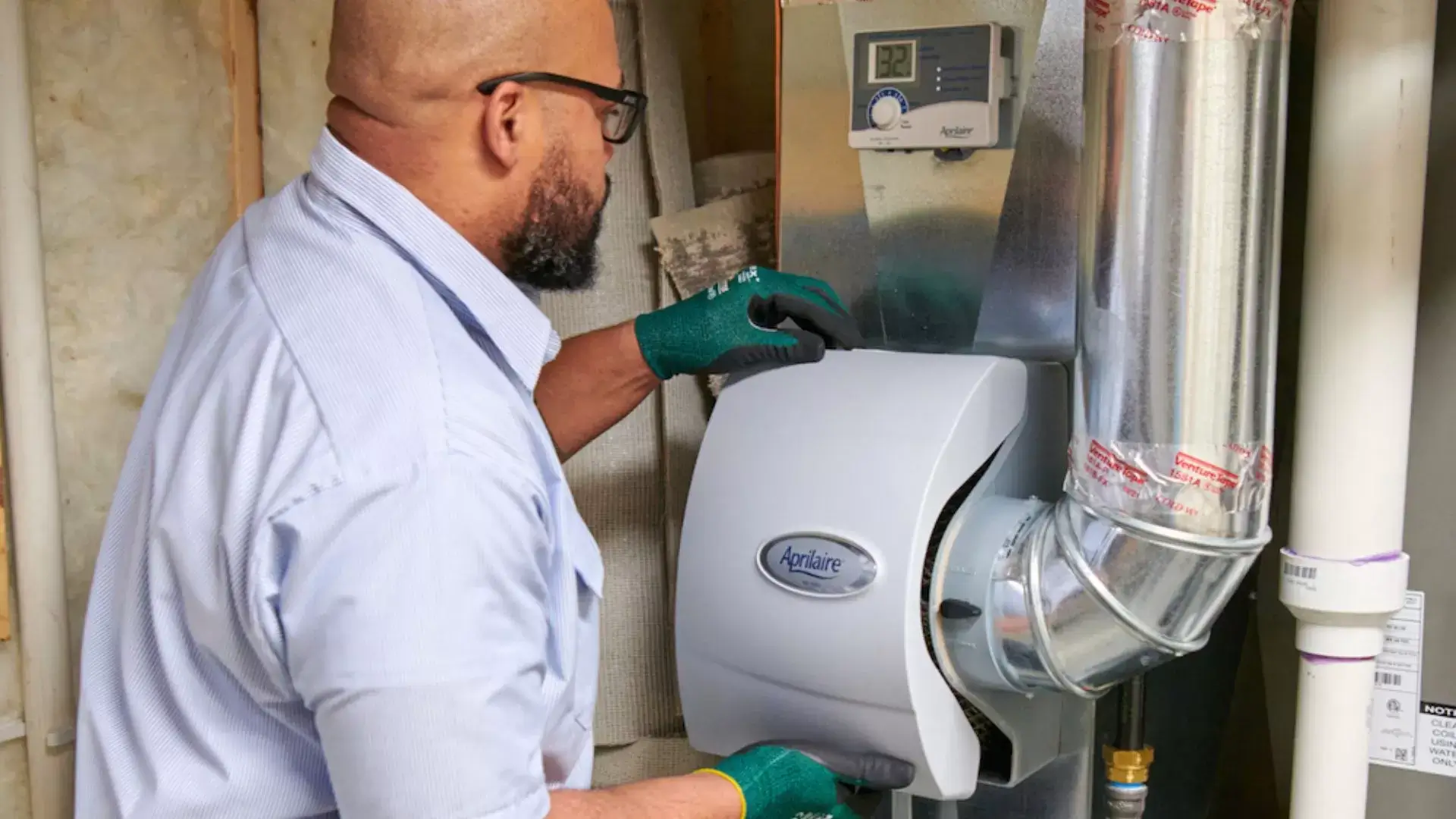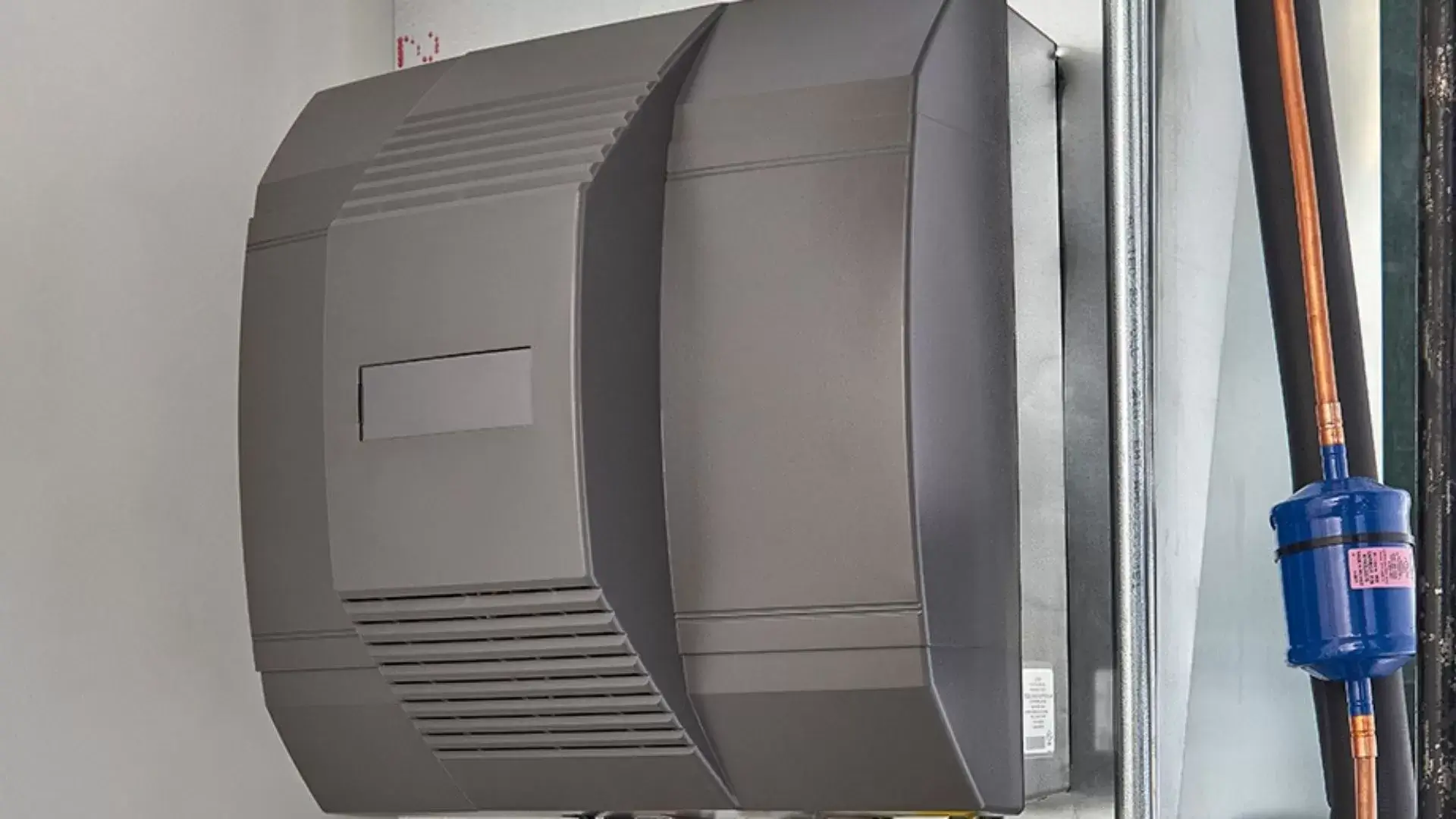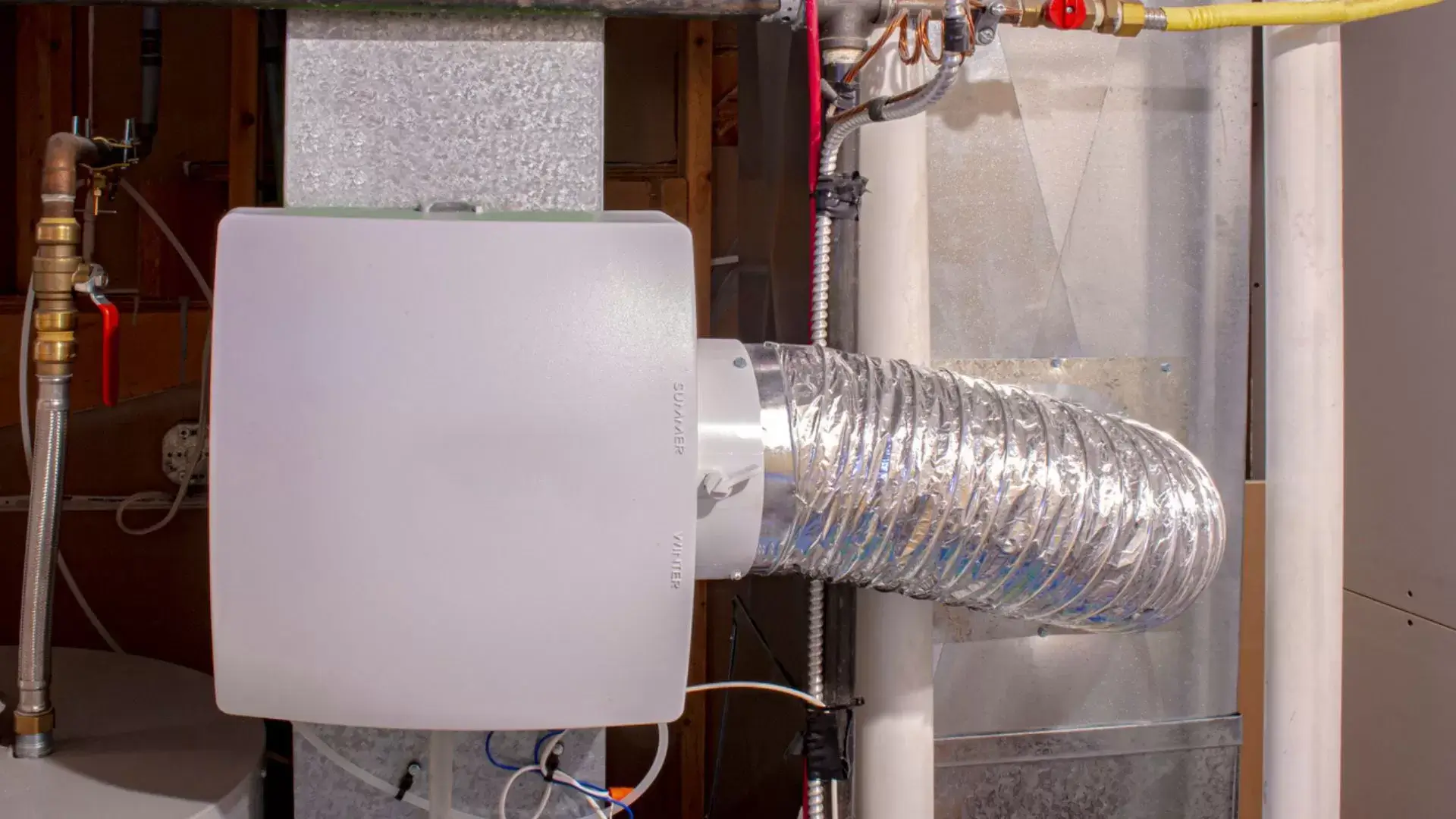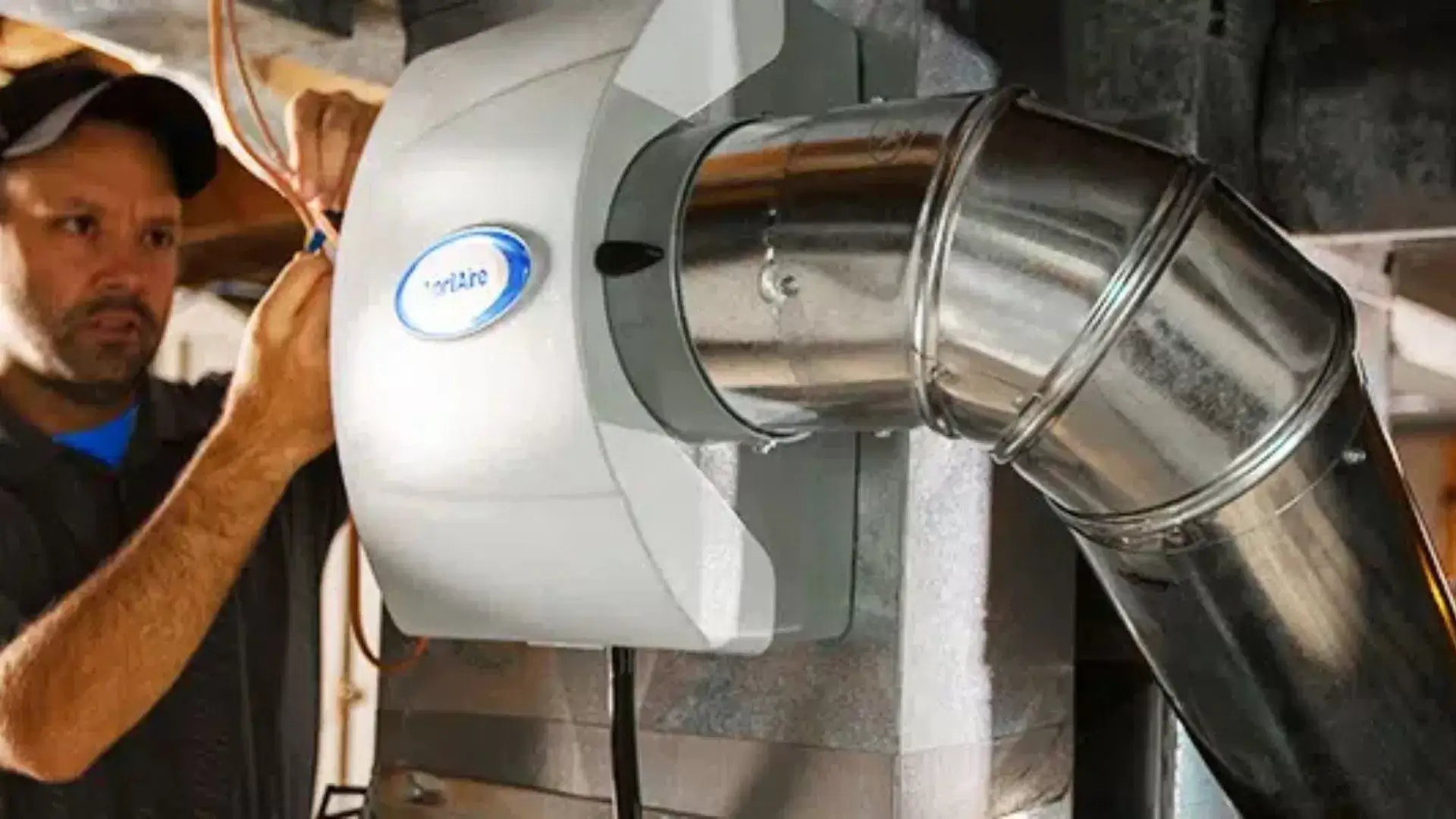Hamilton Humidifier Installation - Hamilton Furnace and Air Conditioning
When installing a humidifier in Hamilton, we focus on enhancing indoor air quality and comfort. Start by choosing a suitable humidifier that matches your home’s size and needs. We recommend preparing your HVAC system by evaluating ductwork and ensuring proper connections. The installation process includes securing the humidifier near the furnace and connecting necessary components for ideal airflow. Hiring professionals guarantees system efficiency and safety, reducing risks of water damage or improper function. With our guidance, you can enjoy the benefits of consistent humidity levels, and discovering more details will help maximize your humidifier’s performance.

Understanding Humidifiers: Enhancing Indoor Air Quality
Humidifiers play an important role in enhancing indoor air quality by adding moisture to the air, which can alleviate discomfort caused by dry environments. When we consider humidifier installation, it’s essential to evaluate our needs, as not all homes require the same type of system. A whole-house humidifier may be ideal for those of us seeking thorough humidity control, ensuring consistent moisture levels throughout the entire dwelling.
Proper humidifier sizing is critical, as an undersized unit may struggle to maintain desired humidity levels, while an oversized one can lead to excessive moisture and mold growth. We should also focus on humidifier air circulation to optimize efficiency, ensuring that the humidified air reaches every corner of our living spaces.
Regular humidifier maintenance is important for sustained performance. Clogged filters or mineral buildup can hinder humidifier efficiency, leading to less effective moisture distribution. For those of us suffering from allergies, using a well-maintained humidifier can greatly improve indoor air quality by reducing allergens and irritants.
Investing in an energy-efficient humidifier not only benefits our health but also our utility bills. By choosing the right system, we can enhance our comfort and well-being while minimizing energy consumption. Ultimately, understanding how to effectively integrate a humidifier into our homes can lead to a healthier living environment for everyone.

What Is a Humidifier?
A humidifier is a device designed to add moisture to the air, helping us maintain ideal humidity levels in our living spaces. By utilizing a humidifier, we can combat the discomfort caused by dry heat, especially during colder months. There are various types of humidifiers, but central humidifiers are particularly effective for whole-home humidity control, ensuring every room benefits from balanced moisture.
When we think about humidifier installation, it’s important to follow a thorough humidifier installation guide. This guide helps us understand the specifics of our humidifier setup, including connecting to the humidifier water supply and ensuring proper placement for peak performance. A well-installed humidifier will often feature a humidity sensor, which monitors the air’s moisture level and adjusts the output accordingly, maintaining a comfortable environment.
To keep our humidifier running efficiently, we must adhere to a humidifier maintenance schedule. Regular maintenance can prevent issues and extend the lifespan of our unit. If we encounter any problems, having a humidifier troubleshooting plan in place can save us time and frustration.
Why Should You Install a Humidifier in Your Hamilton Home?
Installing a humidifier in your home offers several advantages, including:
Improved Air Quality: Helps reduce respiratory discomfort by maintaining optimal moisture levels.
Health Benefits: Reduces dry skin, allergies, and respiratory infections.
Better Sleep Quality: Moist air prevents throat irritation and nasal dryness.
Protects Home Interiors: Prevents cracks in wooden furniture and walls due to dryness.
Increased HVAC Efficiency: Balanced humidity levels can make your heating and cooling system work more efficiently.
Choosing the Right Humidifier for Your Needs
When selecting the right humidifier for our needs, it is important to contemplate factors such as room size, humidity levels, and specific features that can enhance performance. One of the first decisions we need to make is whether we want a portable home humidifier system or an HVAC humidifier that integrates with our existing heating and cooling systems. For larger spaces, an HVAC humidifier often proves more effective, while smaller areas may benefit from a portable model.
We should also consider our specific needs, such as addressing dry skin. A humidifier for dry skin can greatly improve comfort, particularly during harsh winter months. If we opt for a smart humidifier, it may come equipped with a humidifier control panel and a humidifier with thermostat capabilities, allowing us to maintain ideal humidity levels automatically.
Furthermore, understanding the humidifier installation cost is necessary. Professional humidifier installation guarantees that the system is set up correctly and operates efficiently, reducing potential issues down the line. We should also be aware of the availability of humidifier replacement parts, as regular maintenance (like changing the humidifier water panel) is essential to the longevity and performance of our unit.
Ultimately, by evaluating these factors, we can make an informed decision that best suits our home’s needs and enhances our indoor air quality effectively.

Types Of Humidifiers and Their Features
Selecting the right humidifier depends on your home’s size, HVAC system compatibility, and budget. Here are the main types:
1. Bypass Humidifiers
Connects to the HVAC system’s ductwork.
Works with the furnace to add moisture to the air.
Energy-efficient and ideal for medium to large homes.
2. Fan-Powered Humidifiers
Operates independently from the furnace blower.
Produces more moisture and is suitable for larger homes.
Consumes slightly more energy due to the built-in fan.
3. Steam Humidifiers
Provides the most effective humidity control.
Generates steam independently and distributes it through the duct system.
Requires more maintenance but is highly efficient.
4. Portable Humidifiers
Standalone units that do not require HVAC integration.
Ideal for single rooms or apartments.
Needs regular refilling and maintenance.
Preparing Your HVAC System for Humidifier Installation
Preparing our HVAC system for humidifier installation involves several important steps to guarantee peak functionality and efficiency. First, we need to assess our existing Hamilton furnace and air conditioning setup to verify compatibility with a humidifier system. This includes evaluating the capacity of our HVAC system humidifier, as it should adequately meet our home humidity levels.
Next, we’ll plan for the humidifier ductwork, which is essential for proper air distribution throughout our home. We want to make sure that the humidifier connection to the ductwork is secure and that there’s ample space for installation. Proper placement is key to maximizing the benefits of humidifier integration and enhancing our whole-home air quality.
Additionally, we should consider the humidistat installation, which controls the humidity levels in our home. A well-placed humidistat will help us monitor and adjust settings according to our comfort preferences, ensuring peak performance.
It’s also important to prepare for humidifier drain maintenance. We’ll need to verify proper drainage systems are in place to prevent water damage and make sure that the humidifier operates efficiently. This preparation is essential for maintaining the longevity of our equipment and avoiding potential issues down the line.

HVAC System Requirements for Installing a Humidifier
Before installing a humidifier, it’s crucial to check whether your existing HVAC system is compatible. Key factors include:
Ductwork Availability: Whole-home humidifiers require proper ductwork.
Furnace Type: Gas and electric furnaces work best with humidifiers.
System Capacity: Ensuring your HVAC can handle the additional moisture load.
Existing Air Quality Conditions: Identifying if air purification is needed alongside humidification.
Choosing a Professional Installation Service in Hamilton
To ensure your humidifier functions optimally, selecting a qualified professional is key. Here’s what to consider:
Experience and Certification: Ensure the service provider has expertise in HVAC humidifier installations.
Customer Reviews: Look for positive feedback from previous customers in Hamilton.
Warranty and Service Agreements: Check if the provider offers post-installation support.
Pricing Transparency: Get a detailed quote before committing.
The Humidifier Installation Process
Installing the humidifier requires careful attention to detail to guarantee it integrates seamlessly with our HVAC system and operates effectively. First, we’ll need to select the ideal location for our humidifier, typically near the furnace for maximum airflow. We’ll then begin the humidifier installation by mounting the unit and connecting it to the humidifier bypass damper, which regulates airflow between the humidifier and the heating system.
Next, we’ll install the humidifier solenoid valve, which controls the water supply to the unit. It’s essential that we connect the humidifier water line and verify proper water line cleaning to prevent blockages. After this, we’ll set up the humidifier drain line, directing excess water appropriately to avoid damage to our home.
Once the plumbing connections are secure, we’ll focus on the electrical components. We’ll connect the humidifier fan to our thermostat to enable automatic operation based on humidity levels. We also need to check that the humidifier hard water filter is in place to combat mineral buildup, ensuring effective humidity enhancement.
Equipment Needed for Installation
To install a humidifier properly, professionals use:
Drill and Screws: For mounting the humidifier to the ductwork.
Tubing and Valves: To connect the water supply.
Electrical Wiring Kit: For power connection.
Humidistat: To regulate humidity levels.
Step-By-Step Humidifier Installation
Inspecting the HVAC System: Ensuring compatibility.
Choosing an Ideal Location: Mounting the humidifier on the return or supply duct.
Connecting the Water Supply: Using a bypass valve or a direct connection.
Wiring the Unit: Connecting the humidistat to control humidity levels.
Testing the System: Ensuring proper function and moisture distribution.
Final Adjustments: Setting ideal humidity levels and providing maintenance instructions.
Why Professional Installation Is Recommended
Opting for professional installation of our humidifier guarantees that the system functions efficiently and adheres to safety standards, ultimately protecting our home from potential water damage and HVAC issues. When we hire an HVAC contractor for humidifier installation, we can be confident that they possess the expertise to handle the complexities involved. This is especially vital during a humidifier system upgrade, where precise adjustments are made to guarantee peak performance.
One key aspect is the correct humidifier placement. A professional will know the best location to install the unit, assuring proper airflow and distribution of moisture throughout our home. This strategic placement also aids in automatic humidifier function, allowing for seamless adjustments based on the humidifier water level.
Furthermore, professionals are trained in humidifier leak prevention strategies, greatly reducing the risk of water damage. They also address humidifier mold prevention, making certain that the system remains hygienic and safe for our family.
Additionally, a well-installed furnace humidifier can lead to improved humidifier noise reduction, creating a more peaceful living environment. By engaging a professional, we can rest assured that every detail is addressed, providing us with peace of mind and a system that operates efficiently.
Advantages Of Hiring a Professional HVAC Technician
Expertise & Precision: Ensures proper humidifier placement and functionality.
Avoids Installation Errors: Improper setups can lead to leaks or damage.
Compliance with Safety Standards: Professionals adhere to HVAC safety regulations.
Warranty Protection: Many manufacturers require professional installation to maintain warranties.
Common Problems and Solutions
Even with professional installation, we might encounter common problems with our humidifier, but understanding these issues and their solutions can help us maintain ideal performance. One frequent issue is inadequate mist output. If we notice reduced humidity levels, it might be time for a humidifier wick filter or humidifier pad replacement. These components can become clogged or worn over time, affecting our air moisture balance.
Another concern is the presence of bacteria or mold. Regular humidifier bacteria treatment is essential, especially for those of us using a humidifier for winter. We should clean our units consistently to prevent growth, ensuring healthier air quality in our homes. If we’re using a portable humidifier, we need to be diligent about maintenance since they can also harbor bacteria if not properly cleaned.
Sometimes, a malfunctioning humidifier pressure switch might be the culprit behind our humidifier’s inefficiency. If we suspect this, it’s wise to consult a professional for humidifier repair. Additionally, if we’re experiencing hard water issues, a humidifier water softener can help improve performance and prolong the life of our equipment.
Issues with Furnace Humidifier Installation
Even with professional installation, issues can arise. Here are common problems and their solutions:
Low Humidity Levels: Check for clogged filters or improper humidistat settings.
Water Leaks: Ensure tubing is securely connected and valves are functioning.
Excess Moisture: Adjust humidistat settings to prevent condensation and mold growth.
Safety Risks Associated with Improper Installation
Electrical Hazards: Incorrect wiring can lead to short circuits.
Water Damage: Improperly connected water lines can cause leaks.
HVAC System Strain: Incorrect humidity levels can overwork your HVAC unit.
Understanding Installation Costs
Cost of Professional Installation in Hamilton
Professional installation costs vary based on:
Humidifier Type: Steam humidifiers cost more than bypass models.
HVAC System Complexity: Custom installations require more labor.
Additional Features: Smart humidistats or high-capacity units increase costs.
Alternative Humidification Methods
Understanding installation costs is vital for budgeting our humidifier project effectively and guaranteeing we get the best value for our investment. When we consider the installation of an ultrasonic humidifier, evaporative humidifier, or bypass humidifier, we must account for various factors that influence the overall cost.
First, the type of humidifier we choose plays a significant role. For instance, a steam humidifier often requires a more complex humidifier power supply, which could increase installation expenses. Additionally, if we opt for a system that involves humidifier hose installation, the costs can also rise due to the labor and materials needed.
We should also consider the specific requirements for humidifier air intake. Proper airflow is critical for effective air humidification, and any modifications to our existing HVAC system may incur additional costs. If we’re looking to address issues like dry air solutions or find a suitable humidifier for asthma relief, it’s important to consult with professionals who can provide accurate estimates based on our unique situation.
Lastly, it’s wise to factor in ongoing maintenance costs. Some systems may need regular servicing to guarantee peak performance. By understanding these various installation costs, we can make informed decisions that align with our budget while making sure our home remains a comfortable haven. Ultimately, thorough planning will help us enjoy the benefits of our humidifier without unexpected financial surprises.
DIY Humidifier Installation: Is It Worth It?
While some homeowners attempt DIY installation, it’s often best to leave it to professionals due to:
Complex HVAC integrations
Water supply line adjustments
Electrical safety concerns
Maintaining Your Humidifier for Long-Term Performance
Essential Maintenance Tips
Regular Cleaning: Prevents mold buildup inside the unit.
Filter Replacements: Change filters every few months.
Water Line Inspections: Check for blockages or leaks.
Seasonal Adjustments: Increase humidity in winter, reduce in summer.
Troubleshooting Common Humidity Issues
Dry Air Despite Humidifier Use: Increase humidistat settings or check for leaks.
Overly Moist Air: Lower settings to prevent mold growth.
Musty Smells: Clean the unit to remove bacteria buildup.
Contact Hamilton Furnace and Air Conditioning for Your Humidifier Installation
If you’re looking for a professional humidifier installation service in Hamilton, Hamilton Furnace and Air Conditioning is your trusted partner. Our certified HVAC experts provide:
Top-quality installations
Reliable maintenance services
Affordable pricing and warranties
Fast response times
Call us today to schedule an appointment!
Frequently Asked Questions (Humidifier FAQs) – People Also Ask
What Is the Best Type of Humidifier for My Home?
The best humidifier depends on your home’s size and heating system. Whole-home steam humidifiers are best for large homes, while portable units work well for small spaces.
Is There Any Way to Reduce the Cost of Professional Installation Services in Hamilton?
Yes, consider seasonal promotions, bundle HVAC services, or inquire about financing options.
Are There Any Safety Risks Associated with Using a Humidifier?
Yes, risks include mold growth, over-humidification, and electrical hazards if installed improperly.
How Often Should I Clean and Maintain My Humidifier?
Clean your humidifier every 1-2 months and replace filters as recommended by the manufacturer.
What Are the Most Common Issues with Home Humidity Levels?
The most common issues include dry air causing respiratory problems, excess moisture leading to mold growth, and fluctuating humidity levels due to incorrect settings or faulty humidistats.
